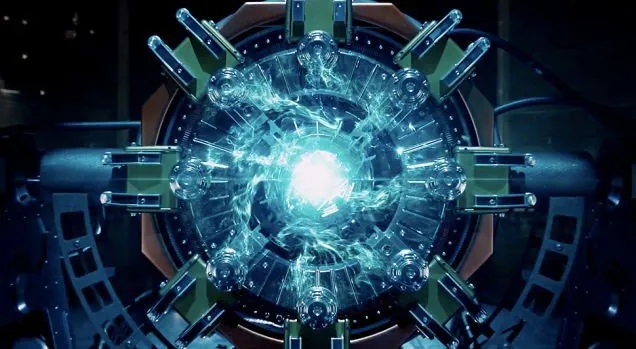
ANTI-MATERNITY IS ONE OF THE MOST PROMISING STUDY FIELDS FOR CURRENT SCIENCE. EVEN THOUGH WE IGNORE MORE THAN WHAT WE KNOW ABOUT IT, THE LITTLE WHAT WE KNOW IS FASCINATING
Antimatter is in itself a fascinating concept, as well as a pretext often aided in explaining science fiction fuels or theories about how matter appeared in the universe. The truth is that antimatter is something quite real (in fact may be the reality itself), and has fascinating aspects like these:
1. The antimatter must have annihilated all the matter of the universe
According to theory, the Big Bang should have created an equal amount of matter and antimatter, which, as soon as they were found, would annihilate each other, leaving energy behind. The beginning of the universe must have been - theoretically - its end. Why did it not happen?
The calculations indicate that (for all of us), from the beginning there was an extra particle of matter for every billion pairs of matter and antimatter. The poetic fundamental asymmetry of the universe remains a subject of research.
2. Antimatter is closer than you think
The antimatter constantly falls to the Earth in the form of cosmic rays and particles of energy; These "rains" fall in ranges ranging from less than one per square meter to more than 100 per square meter. There seems to be evidence of antimatter production in thunderstorms.
3. Humans have created very little antimatter
Antimatter is capable of releasing large amounts of energy; 1 gram only can produce an explosion comparable to that of an atomic bomb. However, all the antimatter created by humans probably would not reach even 1 gram.
The Tevatron particle accelerator created 15 nanograms, and CERN's only 1 nanogram. Germany's DESY laboratory has produced only 2 nanograms. If all the antimatter produced by humans was annihilated in an instant, there would probably be no energy to heat a cup of tea.
4. Antimatter weapons?
Although it may seem out of science fiction, the probability of creating antimatter weapons exists ... although it is expensive. Producing 1 gram of antimatter would require approximately 25 million million kilowatt-hours of energy, at a cost of more than 1 million million dollars. That's not counting storage costs.
5. There are antimatter traps
Researchers have succeeded in isolating antimatter in devices called Penning traps, which are ionic traps resembling small accelerators, within which particles can remain in motion while electric fields prevent them from colliding with the walls.
There are particles that can not be contained in this way, like the antihydrogen that has no electric charge; To trap them requires other types of traps that generate magnetic fields in all directions, so that the particles are trapped in the weakest magnetic field, like a marble in a bowl. The Earth's magnetic field also functions as a great trap. The antiprotons that are trapped there reach areas known as Van Allen radiation belts.

6. To study antimatter a particle decelerator is necessary
The CERN is home to a machine called a "particle decelerator", a storage ring that can capture and slow down the antiprotons to study their behavior and properties. Just as a particle accelerator gives an energy blow at the end of each rotation, a decelerator does the opposite: instead of adding energy, the particles receive a blow in the opposite direction, to slow down.
7. Neutrinos could contain their own antiparticles
A particle of matter and its counterpart of antimatter carry opposite charges, which makes them easy to distinguish. Neutrinos - particles that have almost no matter and seldom interact with it - have no charge; Scientists believe that neutrinos could be fermions of Majorana, hypothetical particles that carry their own antiparticle with them.
8. Antimatter can be medicinal
Positron emission topography (PET) uses these particles to produce high resolution images of the body. Positrons that emit radioactive isotopes are allied with chemicals such as glucose, which are injected into the bloodstream where isotopes are released when they are processed by the body. When released they are annihilated, which produces gamma rays, used to construct the images.
9. The antimatter that should have annihilated the universe must still be around
The problem of asymmetry between matter and antimatter implies that there may still be remains of the Big Bang. The Alpha Magnetic Spectrometer is a particle detector placed on the International Space Station, and is responsible for looking for precisely such remains. Your detector identifies and classifies the particles that occur around it.
10. Antimateria, the energetic of the future?
Since a small amount of antimatter is capable of producing large amounts of energy, the propulsion of vehicles driven by it is hypothetically possible. The limitation, as we have seen, is to find or dispose of sufficient antimatter. There are experiments that simulate propulsion and storage, but are in an extremely early stage of development.
Watch video:
Source: https://www.acs.org/content/dam/acsorg/education/resources/highschool/chemmatters/articlesbytopic/nuclearchemistry/chemmatters-april2005-antimatter.pdf
http://bccp.berkeley.edu/o/Academy/pdfs/BCCPteachLinder0.pdf
http://www.stfc.ac.uk/files/partner-publications/antimatter/
Video credit: Alltime10s
